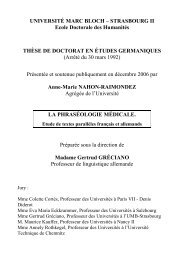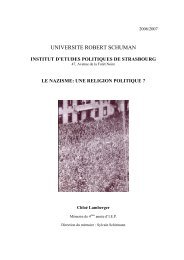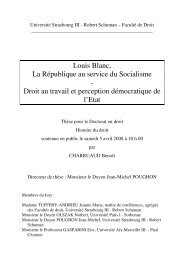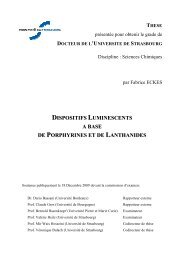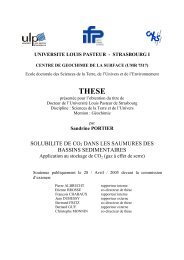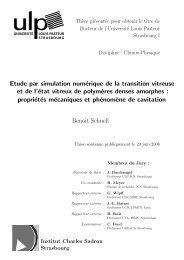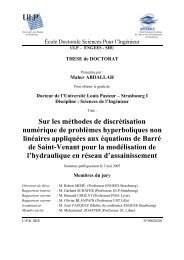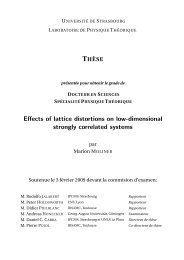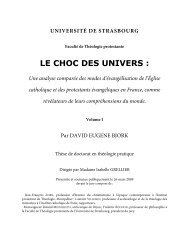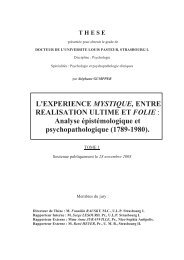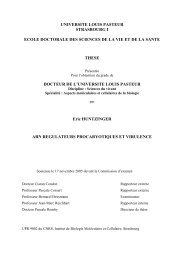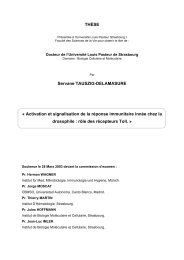Économie Évolutionniste et Culture d'Entreprise
Économie Évolutionniste et Culture d'Entreprise
Économie Évolutionniste et Culture d'Entreprise
Create successful ePaper yourself
Turn your PDF publications into a flip-book with our unique Google optimized e-Paper software.
En plus de c<strong>et</strong>te opacité quant au potentiel évolutionnaire des routines, leur définition même chez Nelson<br />
<strong>et</strong> Winter (1982) pose problème. Ces derniers ont en eff<strong>et</strong> défini les routines à la fois comme génotype <strong>et</strong><br />
comme phénotype. Tout d’abord, ils ont commencé par définir les routines en termes de modèles de<br />
comportement réguliers <strong>et</strong> prévisibles (p. 14) 26 . Ici, les routines correspondent à un comportement<br />
manifeste (une caractéristique phénotypique) plutôt qu’à des règles ou des structures génératives qui<br />
donneraient lieu à de tels comportements ou caractéristiques. La même accentuation du comportement est<br />
évidente dans ce passage :<br />
It is that most of what is regular and predictable about business behavior is plausibly subsumed under the heading ‘routine,’<br />
especially if we understand that term to include the relatively constant dispositions and strategic heuristics that shape the<br />
approach of the firm to the nonroutine problems it faces. (Nelson <strong>et</strong> Winter, 1982, p. 15).<br />
Cependant, en considérant la routine comme un comportement, elle est décrite dans le même temps<br />
comme des dispositions ou comme une mémoire organisationnelle qui donnent forme à l’approche de la<br />
firme des problèmes qu’elle rencontre (c’est-à-dire comme un génotype). Dans ce passage où Nelson <strong>et</strong><br />
Winter définissent les routines comme un programme informatique (génotype) <strong>et</strong> le comportement de<br />
l’ordinateur qui en résulte (phénotype), l’ambiguïté de la définition des routines est manifeste :<br />
We use “routine” in a highly flexible way, much as a ‘program’ (…) is used in discussion of computer programming. It may<br />
refer to a rep<strong>et</strong>itive pattern of activity in an entire organisation, to an individual skill, or, as an adjective, to the smooth<br />
uneventful effectiveness of such an organisational or individual performance. (Nelson <strong>et</strong> Winter, 1982, p. 97).<br />
Comment les routines peuvent-elles être dans le même temps des comportements <strong>et</strong> des dispositions ?<br />
C’est-à-dire à la fois un potentiel <strong>et</strong> la structure qu’il génère ? Hodgson (2003) soulève c<strong>et</strong>te ambiguïté<br />
persistante dans la définition des routines chez Nelson <strong>et</strong> Winter en soulignant la nécessité de reconsidérer<br />
c<strong>et</strong>te définition :<br />
Nelson and Winter confusingly define routines as both genotypes and phenotypes. The upshot is that we have to reconsider<br />
their definition, and make the nature of the routine and its mechanisms of inheritance sufficiently transparent. (Hodgson, 2003,<br />
p. 360).<br />
S’ils ont clairement établi que l’évolution économique est une évolution Lamarckienne, Nelson <strong>et</strong> Winter<br />
n’en précisent ni la substance ni les mécanismes. Il demeure donc nécessaire de préciser la nature des<br />
réplicateurs <strong>et</strong> des interacteurs ainsi la relation qui les relie, bien que Winter estimait récemment que la<br />
spécification d’une une réelle unité de sélection en économie n’était pas un problème fondamental :<br />
[The] question about wh<strong>et</strong>her routines sort of disappear as units of selection if, in fact, they are unique either individually or<br />
unique as bundles seems to me to point to a problem that is more serious for the resource-based view than it is for evolutionary<br />
theory. I think that the RBV may overemphasize that “uniqueness” word in its account. It seems to me that if that critique were<br />
26 C’est c<strong>et</strong>te définition que donnait Winter déjà en 1964, dans une de ses premières conceptualisations du concept<br />
“routine” (simplement en note de bas de page) où il la décrivait sciemment comme un modèle de comportement répété : “I use<br />
the word ‘routine’ here to mean a pattern of behaviour that is followed repeatedly, but is subject to change if conditions<br />
change. If the patterns of behaviour were not subject to change, then description of it would be a characterisation of the firm’s<br />
organisation form.” (Winter, 1964, p. 264 f).



